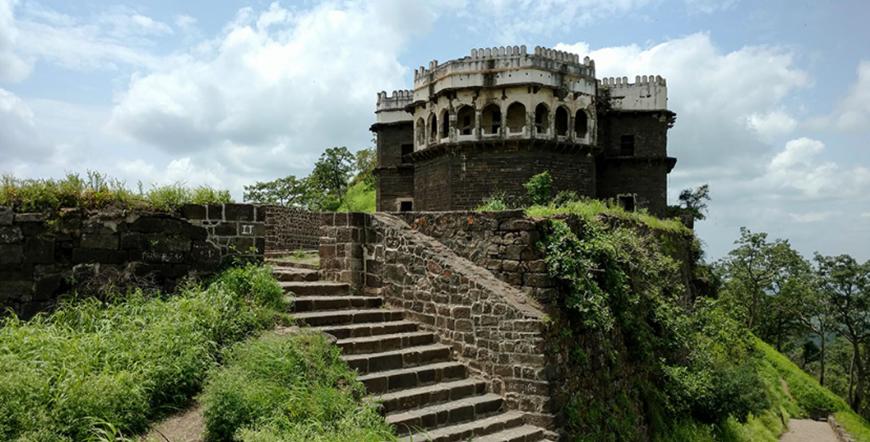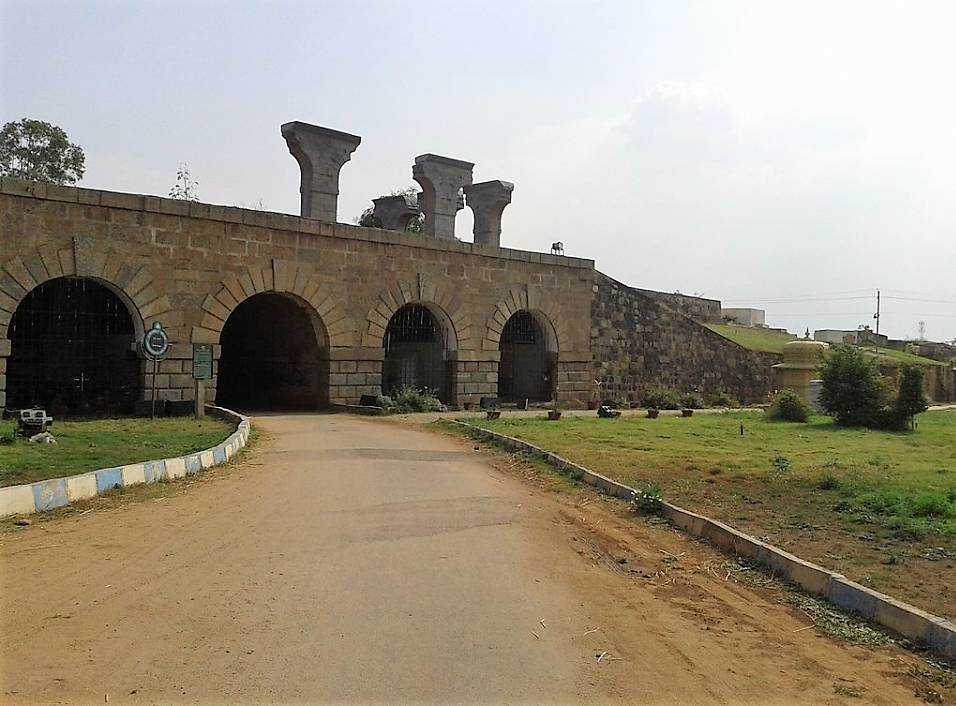The Deccan has been the Gateway to the South India, This area has seen major power struggle ,The Mughal emperor Aurangazeb spent his life time consolidating the Mughal power in Deccan further in South. These forts also saw a lot of action during the British, Maratha,power struggle.
1. Raigad Fort, Pune

The fort of Raigad is situated in the Mahad district of Maharashtra, India. It is one of the oldest and most fortified fortresses of the Deccan Plateau. Today, it is a popular tourist destination. The fort offers many different activities and sights. Raigad is a popular destination for people who want to experience an old-world feel. Its unique fort has many historical relics and is worth a visit.
Built in 1674, the Raigad Fort was captured by the British in 1818. Although it has since been restored, many parts of it have undergone changes. A team of 50 students recreated the original architecture of the fort. A 3-D model of the fort will be showcased during the Diwali festival. Further, the fort has an exhibition highlighting various aspects of its history. You can even participate in the celebrations if you want to.
In addition to its fort, Raigad offers a number of other tourist attractions. A historical temple dedicated to Lord Shiva is one of the must-see sites in Raigad. It is also home to the Jijamata Palace, a memorial to the birth mother of Chhatrapati Shivaji Maharaja. The Raigad Museum showcases weapons used during the times. Rare artifacts, photographs, and scripts are also on display.
To visit the fort, you can take the cable car or trek up the hill. It takes around one and a half hours for the Ropeway to reach the top. If you are an experienced trekker, you can even reach the top in an hour. Just be sure to bring a good flashlight with you so you can see everything in the dark. In addition, while you’re trekking at night, make sure to keep an eye out for creepy crawlers and crawling creatures. Avoid sitting near corners and stay in an open area where you can get a clearer view of everything.
2. Lohagad Fort Pune

Visit Lohagad Fort, located seven kilometers south of Malavali station on the Pune-Mumbai railway line. Located on the banks of the Indrayani and Pavana rivers, the fort is 3400 feet above sea level. When monsoon season approaches, the terrain turns muddy. Trekking is an excellent option. It is a good way to explore the beautiful fortress.
A large fort spread across a hill, Lohagad is home to four entrances, the main Maha Darwaja, Ganesh Darwaja, and Hanuman Darwaja. The entrances are beautifully carved and feature admirable architecture. The other three entrances, Narayan, and Hanuman, are equally impressive. There’s even a small cave located near one of the entrances.
There are many attractions at Lohagad fort, including its ponds. The fort is most beautiful during the monsoon season, when the fort is surrounded by a mist. This also means cooler weather, as rains reduce the heat of the sun. However, the fort trails and roads are often wet and muddy. Rainwater can also run over the steps and stones, so it is essential to exercise caution and carry supplies.
A well-preserved pond in the fort is one of the oldest structures at the fort. These were hand-carved by the locals. The fort was later enlarged during the medieval period. The fortification covers the plan terrain on the top of a hill. A bridge-like extension extends toward the edge of the cliff, and two gateways allow easy access. The fort is a perfect place for a picnic!
Suggested Tour Packages
- Mumbai Tour Packages
- 2 Days Mumbai Tour Plan
- 3 Days Mumbai Tour Package
- Mumbai Honeymoon Tour Package
- Golden Triangle Tour with Mumbai
- Golden Triangle Tour with Scintillation Goa
- Jaipur Tours
3. Bidar Fort Karnataka

Bidar Fort is a fort located in the city of Bidar, Karnataka, India. It was built by Sultan Ahmad Shah I, who relocated his capital from Gulbarga to Bidar in 1427. During his reign, he built a number of Islamic monuments in Bidar and surrounding areas. Today, the fort is a historical site of interest. The fort and its surrounding area are a popular tourist destination.
The fort was originally built in the 8th century and later rebuilt in 1428, when the Delhi Sultanate occupied the area. The Mughal emperor Aurangzeb captured the fort in 1657, and it was briefly ruled by the Nizam dynasty. After independence, the fort was returned to Karnataka. Today, visitors can enjoy its beautiful gardens and fortifications.
Bidar Fort is located approximately 700 kilometers from Bengaluru. You can catch a bus or train from Bangalore or Hyderabad to reach Bidar. From Hyderabad, the journey takes about 16 hours. The city has several hotels in various price ranges. If you are on a tight budget, consider staying at a cheap hotel in Bidar. Alternatively, if you don’t want to spend too much, you can always rent a car and visit the fort.
The architecture of the fort is stunning. The Takht Mahal is an architectural masterpiece. It was built by Qubil Sultani between 1423 and 1424. It features a central dome and sixteen pillars. Many believe that Aurangzeb prayed in this mosque while visiting the Deccan. It is also a great example of Deccan style architecture. Its dome is huge and the prayer hall has a unique water system.
4. Daulatabad Fort in Aurangabad

If you are planning a visit to Daulatabad Fort in Maharashtra, make sure to visit this fort and its surroundings. This fort is the oldest in the state of Maharashtra and dates back to the 16th century. You can also view the Chand Minar, which is 63 meters high and built to commemorate the victory of the Mughals over Dautlabad. The Chinese palace is also located in the fort and features curved fortifications.
There are several ways to travel to the fort, the most popular of which is to hire a taxi or an auto rickshaw. Make sure to negotiate the fare with the driver before boarding the vehicle. Alternatively, you can hire a private car with chauffeur and drive yourself to Daulatabad Fort. You can book a car from a hotel or travel agency. The cost of a private car is about Rs. 2,000-5,000 and it will take approximately an hour to reach Daulatabad Fort in Aurangabad.
The fort was once a regal residence, but the dynasties that ruled this region left their mark. The fort complex itself was an incredible feat of engineering, with multiple entrances and a tunnel cut out of the surrounding hills. Various structures are preserved inside the fort and include the royal palaces and the 14th-century Jami’ Masjid, or Great Mosque.
5. Golconda Fort Hyderabad

If you are planning to visit Golconda Fort Hyderabad, then you are in the right place! The fort is located about 11 km from the city center. You can also take a bus to reach the fort. If you are traveling by car, you can take a cab or auto rickshaw to reach the fort. It will take around 20 minutes to reach the fort from the city center.
The fort was first built by the Bahamanis, who slowly rose to power and made it their main seat of government. The successive Qutb Shahi dynasty expanded the mud fort, and made it a granite fortification. The fort was then the seat of the Qutb Shahi dynasty until the Mughal Emperor Aurangzeb laid siege to it in 1687.
The fort was originally called Mankal during the Kakatiya dynasty. It was built to protect its territory from western attacks. The Kondapalli Fort, or Capitol Palace, was constructed at a height of 120 feet. The fort’s 390 feet compound wall is covered in granite. Among other things, it was known for its cotton weaving industry. As a result, the fort exported a huge amount of high-quality plain cloth to Europe.
While exploring the fort, you can also check out the cave temples. There are four monuments in the fort, and the boundary wall has 87 bastions and eight entry ways. The interiors of the fort include the Royal Chambers, large Hallways, and temples. You will also find mosques, stables, and magazines. You can spend a whole day at Golconda Fort Hyderabad, if you have time to visit the fort.
Suggested Tour Itineraries
- Taj Mahal Tour from Bangalore
- Golden Triangle Tour of Karnataka
- Golden Triangle Tour with Oberoi Hotels
- Taj Mahal Tour with Mumbai and Udaipur
- Day Tour Taj Mahal from Mumbai or Hyderabad
- Golden Triangle Tour with Aurangabad and Mumbai
6. Panhala Fort

When visiting Panhala, don’t miss the opportunity to see the fort’s imposing doorways. The main entrance, Teen Darwaza, was adorned with Persian inscriptions and carved motifs and featured Lord Ganesh. Aside from the fort’s magnificent doorways, the site features many other historic landmarks that are worth visiting. A visit to this fort is the perfect way to spend a weekend with the family.
The fort was constructed between 1178 CE and 1209 CE by Shilahara. It was under the rule of Bhoja II from 1191 to 1192 CE, and passed to the Yavadas in 1209-10. However, it is unclear exactly when the fort was conquered. While many forts were destroyed during this time, Panhala’s remains still remain. A copper plate in Satara shows that the fort’s fort was once owned by the Kahaan Raja Bhoj.
In addition to the fort’s impressive fortifications, Panhala is home to many other monuments. A few of the most impressive include the Teen Darwaza and the three massive granaries. The largest of these, the Ganga Kothi, covers 950 square meters and is 10.7 metres tall. At present, the fort is used for school boarding and a government office. Tourists come to the town in droves to experience the fort’s history and beauty.
While visiting the fort, make sure to visit the Ambabai temple and Sambhaji Temple. Both of these temples are sacred to Goddess Ambaba. If you are traveling by car, you should make sure to plan your visit accordingly. The fort is approximately twenty kilometers from Kolhapur. You’ll need about forty minutes to reach it. If you’re traveling by train, you’ll take about forty-three minutes to get there.
7. Srirangapatna Fort

There are several things that you can do in Srirangapatna fort. The fort has a rich history and is one of the top tourist attractions in the state. You can see a lot of migratory birds and local people interacting with each other. The fort was built by Tipu Sultan, who also built the Jumma Masjid. It is a major example of Indo-Islamic architecture.
The land is fertile due to the presence of the Cauvery river, which flows through it. Sugarcane and paddy are grown on the fertile soil. You can also see the fortified walls built of different rocks and stones. The fortified walls are a testament to a rich history that is not well-studied. It’s best to visit this fort in the evening when you can enjoy the sunset or a sunrise over the city.
The fort is a prime example of Indo-Islamic architecture. The fort has four imposing gates and double walls of 40 feet. Inside the fort, you’ll find ruins of Tipu Sultan’s residence, the Lal Mahal, which featured grand architecture. The British captured the fort in 1799. There are also dungeons inside the fort. You can tour all of these fascinating structures and enjoy the scenic view of the city.
Inside the fort, you’ll find a poignant monument to a fallen Karnataka warrior. Other attractions inside the fort include a mosque, a Sri Ranganathaswamy Temple, and a dungeon known as Colonel Bailey’s dungeon. You’ll also find many paintings that depict familiar backgrounds from the fort. And don’t forget to check out the dungeon, which was the prison for prisoners.

